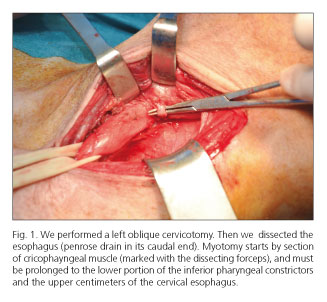Mi SciELO
Servicios Personalizados
Revista
Articulo
Indicadores
-
 Citado por SciELO
Citado por SciELO -
 Accesos
Accesos
Links relacionados
-
 Citado por Google
Citado por Google -
 Similares en
SciELO
Similares en
SciELO -
 Similares en Google
Similares en Google
Compartir
Revista Española de Enfermedades Digestivas
versión impresa ISSN 1130-0108
Rev. esp. enferm. dig. vol.108 no.12 Madrid dic. 2016
https://dx.doi.org/10.17235/reed.2016.4266/2016
LETTERS TO THE EDITOR
Utility of surgical myotomy in the dysphagia due to oculopharyngeal dystrophy
Utilidad de la miotomía quirúrgica en la disfagia por distrofia oculofaríngea
Key words: Oculopharyngeal muscular dystrophy. Cricopharyngeal myotomy. Dysphagia.
Palabras clave: Distrofia oculofaríngea. Miotomía del cricofaríngeo. Disfagia.
Dear Editor,
Oculopharyngeal muscular dystrophy (OPMD) is a rare hereditary myopathy that affects mainly the levator palpebrae and the constrictor pharyngeal muscles, and causes severe dysphagia. It can be treated effectively by surgical cricopharyngeal myotomy, as demonstrated in the case presented below.
Case report
The case was a 69-year-old male suffering from dysphagia to solids and liquids, fever, respiratory secretions, weight loss, bilateral ptosis and dysphonia. Aspiration pneumonia was diagnosed by CT scan. After ruling out neurological focality, the electromyogram revealed a myopathic pattern with acute activity at rest.
The endoscopy failed to reach the esophagus. Videofluoroscopy found adequate tongue propulsion, an elevated epiglottis and an opened laryngeal vestibule (swallow aspiration), inactivity of constrictors causing abolition of the pharyngeal dynamics, absence of upper esophageal sphincter (UES) aperture before swallowing attempts and contrast retention in valleculae and pyriform sinuses (post-swallow aspiration). Manometry showed a normal resting UES tone, maximum pressure peaks of 230 mmHg and adequate pharyngosphincteric coordination, with an "ineffective motility" type disorder in the esophageal body.
Due to a significant deterioration of the patients' health and a genetic study that supported a diagnosis of OPMD, we decided to perform surgery after nutritional optimization with feeding gastrostomy. Extramucosal cricopharyngeal myotomy was performed (Fig. 1). Dysphagia was totally relieved and the patient was discharged on the seventh day, with oral intake, without tracheobronchial relapse symptoms after five months of follow-up.
Discussion
The OPMD raises a diagnostic and therapeutic challenge with respect to other more common causes of oropharyngeal dysphagia (1). Mutations in the PABPN1 gene (also called PABP2) on chromosome 14 (Cr14q11.2-q13) confirmed the diagnosis (2).
In the absence of curative treatment, the multidisciplinary approach aims to improve quality of life and reduce complications. Functional examinations, especially videofluoroscopy, allow the identification of the most appropriate therapeutic strategy for dysphagia (1): rehabilitation techniques (1), botulinum toxin injection (4), dilation (4), endoscopic or surgical UES myotomy. The latter has been shown to be effective in patients with OPMD (3-5).
M.a Asunción Acosta-Mérida1, Joaquín Marchena-Gómez1 and Josefa M.a Afonso-Déniz2
Departments of 1General Surgery and 2Internal Medicine.
University Hospital of Gran Canaria Dr. Negrín. Las Palmas, Canary Islands. Spain
References
1. Clavé P, Terré R, De Kraa M, et al. Approaching oropharyngeal dysphagia. Rev Esp Enferm Dig 2004;96:119-31. DOI: 10.4321/S1130-01082004000200005. [ Links ]
2. Brais B, Bouchard JP, Xie YG, et al. Short GCG expansions in the PAPB2 gene cause oculopharyngeal muscular dystrophy. Nat Genet 1998;18:164-7. DOI: 10.1038/ng0298-164. [ Links ]
3. Gómez-Torres A, Abrante-Jiménez A, Rivas-Infante E, et al. Miotomía del cricofaríngeo en el tratamiento de la distrofia muscular oculofaríngea. Acta Otorrinolaringol Esp 2012;63:465-9. DOI: 10.1016/j.otorri.2012.06.003. [ Links ]
4. Kos MP, David EF, Klinkenberg-Knol EC, et al. Long-term results of external upper esophageal sphincter myotomy for oropharyngeal dysphagia. Dysphagia 2010;25:169-76. DOI: 10.1007/s00455-009-9236-x. [ Links ]
5. Coiffier L, Périé S, Laforêt P, et al. Long-term results of cricopharyngeal myotomy in oculopharyngeal muscular dystrophy. Otolaryngol Head Neck Surg 2006;135:218-22. DOI: 10.1016/j.otohns.2006.03.015. [ Links ]











 texto en
texto en 


